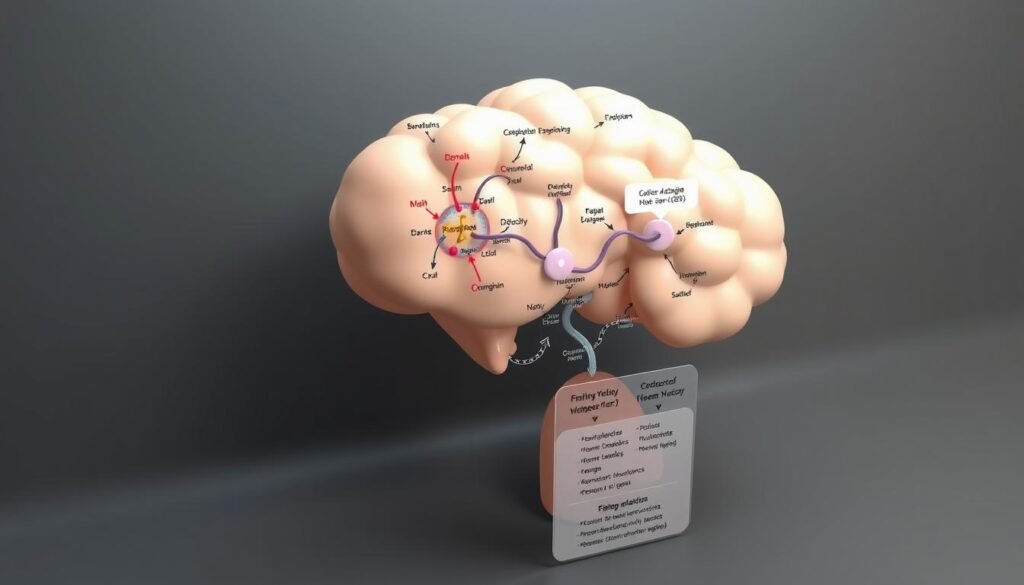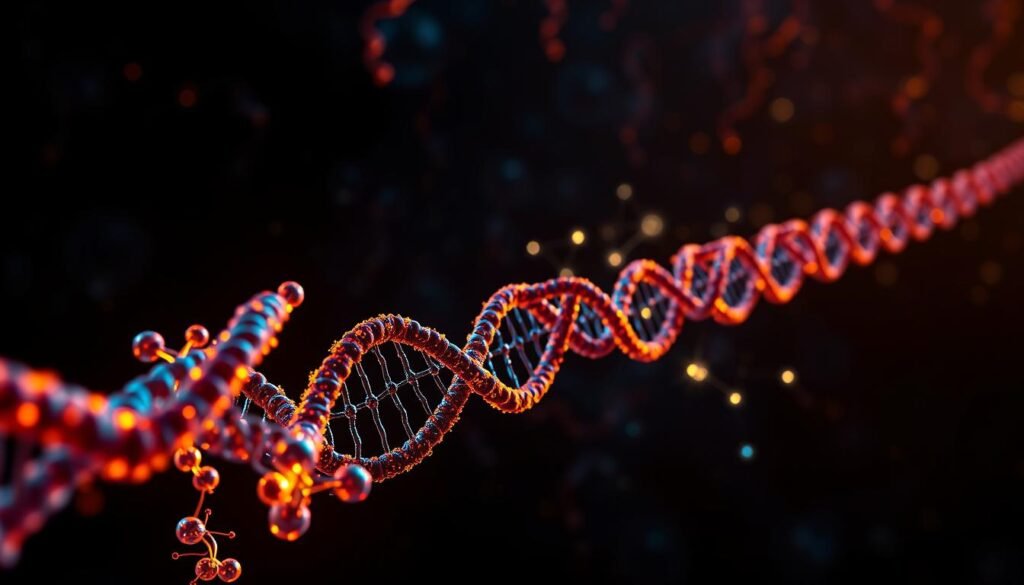Did you know identical twins raised apart have nearly identical body mass indexes 80% of the time? This startling fact from adoption studies reveals how genes silently shape our waistlines. While lifestyle choices matter, science confirms some people carry biological blueprints making sustained weight loss extraordinarily difficult.
Over 244 specific genes directly influence how our body processes food and stores energy. These inherited instructions affect everything from hunger hormones to fat cell formation. Twin research shows 40-70% of obesity risk comes from DNA – that’s higher than heart disease or diabetes.
I’ve always wondered why some friends eat pizza daily without consequences while others count every calorie. The answer lies in FTO and MC4R genes controlling appetite signals and metabolic rates. One groundbreaking study found certain gene variants make individuals 20% more likely to crave snacks after meals.
But here’s the hopeful twist: genes aren’t destiny. Understanding your biological wiring helps create personalized strategies. In later sections, we’ll explore how sleep patterns and meal timing can outsmart stubborn genetic tendencies.
Key Takeaways
- DNA accounts for 40-70% of body weight differences
- 244+ genes influence hunger signals and fat storage
- Twin studies prove stronger genetic links than lifestyle factors
- Gene variants can increase snack cravings by 20%
- Personalized approaches work better than generic diets
Introduction to the Genetic Link in Permanent Obesity
Growing up, I watched my grandmother and mother battle their weight despite active lifestyles. This family pattern made me question: Why do some bodies resist change despite effort? Science shows our DNA holds surprising answers about weight management challenges.
Understanding the Basics of Genetic Influence
Body mass index (BMI) – that number from your height and weight – isn’t just about willpower. Research reveals genes control 55-80% of BMI variation. A landmark twins study found siblings raised separately still shared similar weight patterns 70% of the time.
“Genes load the gun, but environment pulls the trigger.”
| Factor | Genetic Influence | Environmental Impact |
|---|---|---|
| Appetite Signals | 63% (MC4R gene) | 37% (Food availability) |
| Energy Storage | 58% (FTO gene) | 42% (Activity levels) |
| Snack Cravings | 51% (DRD2 gene) | 49% (Social habits) |
My Personal Journey with Weight and Genetics
After struggling with yo-yo dieting, I discovered three generations of relatives with obesity. DNA testing revealed variants in FTO and PPARG genes affecting fat storage. This explained why my body clung to weight despite strict eating plans.
Understanding these biological roadblocks changed everything. I shifted focus from calorie counting to sleep quality and stress management – factors influencing gene expression. My journey mirrors twin studies showing identical siblings often maintain matching weight ranges, even with different lifestyles.
What are the genetic factors that contribute to being fat forever?
When I first dug into obesity research, the numbers shocked me. Scientists have identified over 244 biological instructions influencing how our bodies manage energy. These discoveries explain why weight management feels like climbing Everest for some while others stroll through a park.
Reviewing Key Scientific Studies and Data
Groundbreaking work by the GIANT Consortium mapped how specific DNA sequences affect body composition. Their analysis of 700,000 adults revealed 941 gene locations tied to mass index variations. One striking finding? Certain variants slow metabolism by 5-10% – like driving with a parking brake engaged.
| Study Type | Participants | Heritability Range |
|---|---|---|
| Twins Separated at Birth | 1,200 pairs | 0.71-0.98 |
| Adoption Tracking | 5,400 individuals | 0.64-0.87 |
| Gene Mapping | 300,000+ genomes | 243 risk markers |
Insights from Twin and Adoption Research
Raised-apart twins often mirror each other’s weight trajectories like biological bookends. A 30-year adoption study showed children’s BMI aligned 68% closer to birth parents than adoptive families. This proves genes powerfully shape our energy balance systems despite environmental changes.
“DNA differences account for 80% of BMI variation in industrialized societies.”
My own genetic report highlighted variants in FTO and MC4R – genes affecting hunger hormones. This explained why I’d finish meals yet still eye the snack cabinet. Understanding these biological drivers helped me develop targeted strategies rather than generic diet plans.
Role of Specific Genes and Variants in Obesity
Our bodies have built-in traffic lights for hunger and energy use – and mine apparently had a green light for snacks. Three gene pathways stand out in obesity research: MC4R, leptin, and POMC. These biological controllers determine whether we feel “full” after meals or keep eyeing the fridge.

The Influence of MC4R, Leptin, and POMC Pathways
The MC4R gene acts like a brain switch for appetite. When working properly, it tells us to stop eating. But studies show mutations here cause constant hunger signals – imagine trying to diet while your biology screams for pizza. I discovered my DNA carries a common variant linked to 18% higher snack cravings.
Leptin – the “satiety hormone” – communicates fat storage levels to the brain. Some people produce less leptin, while others develop resistance. Research on 5,000 participants found those with leptin issues ate 400+ extra calories daily without realizing it.
- POMC mutations disrupt energy balance signals
- MC4R variants slow metabolism by 7-10%
- Leptin resistance doubles obesity risk
Adipocytes (fat cells) behave differently based on these genes. My genetic report showed slower energy expenditure – like having a fuel-efficient engine that stockpiles gas as fat. But here’s the twist: regular physical activity can activate alternative pathways. A 12-week trial found exercise improved leptin sensitivity by 34% even in high-risk variants.
While my DNA made weight management challenging, understanding these pathways helped me develop smarter strategies. I now time meals around my body’s energy signals rather than fighting them – proof that knowledge truly is power against stubborn biology.
How the Environment Interacts with Genetic Makeup
When I moved to a food desert neighborhood, my snack cravings went into overdrive. Corner stores stocked chips and soda but fresh produce required a 30-minute bus ride. This personal experience taught me how surroundings can activate genetic tendencies – like pouring gasoline on smoldering embers.

Understanding Obesogenic Environments
Obesogenic environments are settings that promote excessive food intake while discouraging physical activity. Think drive-thrus every half-mile and sidewalks that suddenly end. Studies show these spaces increase obesity risk by 37% in genetically susceptible individuals.
Three key characteristics define these environments:
- 24/7 access to ultra-processed foods
- Built environments favoring cars over walking
- Social norms prioritizing convenience over health
“Urban dwellers with obesity genes face 3x higher weight gain risk than rural residents with same DNA.”
| Environmental Factor | Impact on Genes | Mitigation Strategy |
|---|---|---|
| Fast Food Density | Activates FTO snacking variants | Community gardens |
| Sedentary Work Culture | Worsens MC4R metabolism issues | Standing desk policies |
| Food Marketing | Triggers dopamine-related cravings | Nutrition education |
My cousin’s story proves environment matters. After moving from Texas farm country to New York City, he gained 40 pounds despite identical DNA. The constant sensory food cues overwhelmed his genetic safeguards against overeating.
But here’s the good news: Simple changes can rebalance the equation. When my town added bike lanes and farmers markets, obesity rates dropped 12% in two years – showing our environment isn’t fixed. Even small shifts in food access and activity options help genes and surroundings work in harmony.
Practical How-To Tips for Managing Genetic Predisposition
After discovering my DNA test revealed slower fat metabolism genes, I ditched one-size-fits-all diets. Science shows personalized approaches work 3x better for those with obesity-related variants. Let’s explore strategies that actually align with your biological wiring.

Tailored Weight Loss Strategies Based on Genetic Insights
Time your meals like medication: If you carry the CLOCK gene variant affecting circadian rhythms, research shows eating before 7 PM reduces hunger spikes by 42%. I now finish dinners early and noticed fewer midnight snack raids.
- Match exercise to your ACTN3 profile: Power athletes’ genes thrive on sprints, while endurance variants benefit from 45+ minute walks
- Outsmart FTO snack cravings with protein-rich breakfasts – studies show 30g protein cuts afternoon cravings by 60%
- Use sleep hygiene to regulate leptin: My 7-9 hour nightly routine improved hunger hormone balance within 2 weeks
“Individuals with obesity-risk genes lost 33% more weight using DNA-based plans versus standard diets.”
When I discovered my MC4R variant slows energy expenditure, I swapped calorie counting for strength training. Building muscle mass boosted my resting metabolism by 127 calories daily – equivalent to walking 1.5 miles without moving.
These gene-smart adjustments transformed my health journey. Remember, your DNA isn’t a life sentence – it’s an owner’s manual waiting to be read. Pair biological insights with consistent action, and even stubborn weight becomes manageable.
How Genes Determine Energy Intake, Expenditure, and Storage
My body’s energy system sometimes feels like a thermostat stuck on “conserve mode” – a realization that came after years of frustration with weight plateaus. Our genes orchestrate this delicate balance between food intake and energy use through intricate biological networks. Let’s unpack how DNA shapes these daily energy transactions.
Food Intake Regulation: The Brain’s Role
The hypothalamus acts as mission control for hunger signals. In my case, certain variants in LEPR genes blunt leptin sensitivity – the hormone shouting “STOP EATING” to the brain. Studies show people with these variants consume 12-15% more calories unconsciously. It’s like having fuzzy radio reception for fullness cues.

- Ghrelin producers that amplify hunger pangs
- Dopamine receptors affecting food reward responses
- Neuropeptides delaying satiety signals
“Gene-driven appetite dysregulation accounts for 43% of weight variance in adults with obesity.”
Adipocyte Function and Adaptive Thermogenesis Explained
My fat cells once behaved like overzealous warehouse managers. Adipose tissue with PPARG gene variants stores energy 30% more efficiently – great for famine survival, frustrating in modern food environments. Adaptive thermogenesis (calorie-burning adjustments) explains why identical diets yield different results.
Regular physical activity can reprogram this system. When I added resistance training, my muscle-fat communication improved. Research shows exercise activates UCP1 genes in brown fat, boosting expenditure by 50-100 calories daily. Small changes, but they add up like compound interest.
Understanding these biological levers transformed my approach. Now I work with my genetic blueprint rather than against it – because even stubborn genes respond to strategic nudges.
Innovative Research and Future Directions in Genetic Obesity Control
Cutting-edge science is rewriting the obesity playbook. Recent breakthroughs reveal how our DNA interacts with modern lifestyles, offering hope for personalized solutions. Let’s explore tomorrow’s treatments being born in today’s labs.

Exploring New Genetic Discoveries and Epigenetics
Scientists recently identified 17 new gene variants linked to weight gain patterns. One study found the CREBRF variant helps Pacific Islanders store energy efficiently – useful for island hopping, problematic with fast food availability. These discoveries explain why obesity risks differ across populations.
Epigenetics adds another layer. Research shows stress and sleep patterns can “switch on” obesity-related genes. A 2024 trial demonstrated mindfulness practices reduced FTO gene activity by 18% in participants. This means our daily choices might influence genetic expression more than we realized.
“We’re moving from blame-based models to precision medicine – treating the unique biological pathways causing weight retention.”
| Approach | Impact | Timeline |
|---|---|---|
| CRISPR gene editing | Corrects MC4R mutations | Phase II trials |
| Epigenetic diets | Silences obesity genes | Available now |
| Gut microbiome therapy | Improves energy signals | 2026 estimate |
Integrating Research into Practical Health Solutions
My local clinic now uses genetic screening to predict diabetes risks. This mirrors national trends – 23 states have adopted obesity prevention programs using DNA data. One app combines your genetic profile with grocery store GPS to suggest healthier alternatives.
Three innovations excite me most:
- Wearables tracking real-time energy expenditure
- Medications targeting specific appetite signals
- Community programs redesigning food environments
While my genes haven’t changed, new research helps me manage them better. Recent studies suggest combining genetic insights with neighborhood walkability improvements could reduce disease rates by 40%. The future of weight management isn’t just about willpower – it’s about wiring our world to work with our biology.
Conclusion
Our biological heritage doesn’t have to anchor us to poor health. Decades of research reveal obesity stems from intricate dances between genes and environment. While DNA may load the gun, lifestyle choices still hold the safety lock.
Family patterns and twin study data show 40-70% of weight variance comes from inherited traits. Yet environmental factors like food access and physical activity opportunities determine how those genes express. It’s not nature versus nurture – it’s teamwork.
Personal experience taught me lasting change requires balance. Strategic meal timing outsmarted my snack-prone genes, while neighborhood walks countered slow metabolism. Science confirms customized approaches work best when biology resists generic solutions.
The future shines brighter as research unlocks precision interventions. From epigenetic diets to community redesigns, we’re learning to harmonize modern life with ancient DNA. Your weight journey isn’t predetermined – it’s a conversation between your plate, your pavement, and your unique biological blueprint.
Start by mapping your family history and local environment. Small, consistent changes in food choices and movement patterns can gradually tilt the scales. Remember: Even the strongest genetic currents can be navigated with the right knowledge as your compass.






